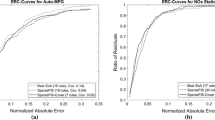Abstract
The sparse distributed architecture described would be shown to function effectively as a fuzzy inference system giving essentially the same results as conventional techniques. However, whereas the conventional model reaches a glass ceiling as the order of target systems increases due to computer architectural limitations, this design is able to surpass this limit. It uses the same principles of max–min composition to solve inference problems, and comprises fuzzy sets that can encode a level of linguistic expression typical of such systems. It however expresses fuzzy sets differently, and performs the required computation in a manner suitable to the alternative representation. It may seem a rather complicated solution for low order problems (which it is) with the situation reversing itself for high order problems, the conventional solution being complicated if not impossible and the new architecture simple. The limitation, errors and performance of the new method when compared to the conventional method is documented and quantified by software written to model the two representations considered.
Similar content being viewed by others
References
Aleksander I, Morton H (1993) Neurons and symbols–the stuff that mind is made of. Chapman Hall, London
Andrews J (1997) Taming complexity in large-scale fuzzy systems PC AI Phoenix Know Technol Inc 11(3):39–42
Austin J (ed) (1998) Ram-based neural networks. Prog Neural Processing World Sci 9:18–30
Chiu S (1996) Method and software for extracting fuzzy classification rules by subtractive clustering. Biennial conference of the North American fuzzy information processing society–NAFIPS (Cat. No.96TH8171), Berkeley, USA: 461-5. NAFIPS–North American fuzzy Inf Process Soc BISC–Berkeley initiative in soft computing IEEE neural networks council. IEEE systems, man and cybernetics society, pp 19–22
Combs W (1995) Reconfiguring the fuzzy rule matrix for large, time-critical applications. Third annual international conference on fuzzy-neural applications, systems and tools, PennWell Publishing Company, 10 Tara Blvd., 5th Floor, Nashua, NH 03062-2801, 18:1–7
Combs W, Andrews J (1998) Combinatorial rule explosion eliminated by a fuzzy rule configuration. IEEE Transact Fuzzy Syst 06(01):1–11
Cox E, O''Hagen M, Taber R (1998) The fuzzy systems handbook, a practitioner's guide to building, using, and maintaining fuzzy systems. Morgan Kaufmann, p 32
Gleik J (1988) Chaos–making a new science. Heinemann, London
Jang J-SR, Sun C-T, Mizutani E (1997) Neuro-fuzzy and soft computing–a computational approach to learning and machine intelligence. Prentice Hall, Upper Saddle River
Kanerva P (1988) Sparse distributed memory. MIT Press, Cambridge, MA, USA
Kong A (2001) Intelligent optimal non-linear control. Proceedings of the International conference on computational intelligence modeling and control (CIMCA'2001). Las Vegas Nevada, pp 472–482
Kong A (2002) Real sparse distributed memory. West Indian J Eng 25(1):52–62
Kong A (2004) Impulse activated sparse cell array network in non-linear autoregressive process modeling. Soft computing–a fusion of foundations, methodologies and applications. Springer, Berlin Heidelberg New York (in press)
Mackey M, Glass L (1988) From clocks to chaos: the rhythms of life. Princeton University Press, New Jersey
Author information
Authors and Affiliations
Corresponding author
Rights and permissions
About this article
Cite this article
Kong, A. Sparse distributed fuzzy inference systems. Soft Comput 10, 567–577 (2006). https://doi.org/10.1007/s00500-005-0518-4
Published:
Issue Date:
DOI: https://doi.org/10.1007/s00500-005-0518-4




